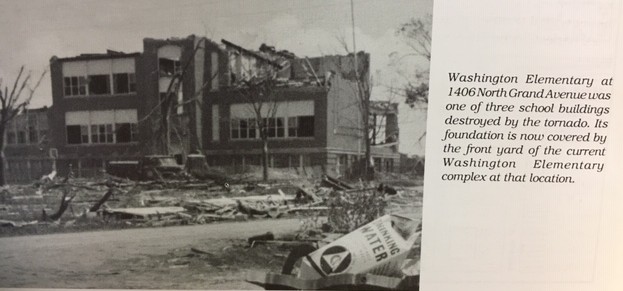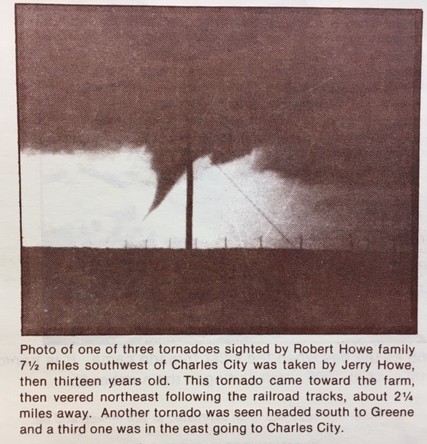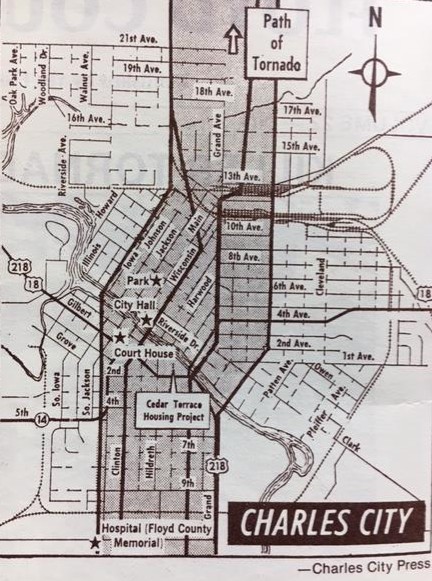The Powerful 1968 Tornado and Its 1993 Commemoration
Charles City, Floyd county, Iowa

While, in 1993, Floyd County residents were preparing to commemorate the 25th anniversary of one of the worst days in their history, the day three tornadoes combined to roar through downtown Charles City and the neighboring countryside, they were warily watching the waters rise on the Cedar River. By March of 1993 the water was already six feet above flood stage. The water was still rising in August. At its crest the river was just .04 inches below the record crest of 21.5 inches.
While flooding can occur in a flash, taking people by surprise, it can also unfold over weeks and months. By contrast, tornadoes strike quickly.
At 4:51 p.m. on May 15, 1968 three tornadoes roared into Floyd County from the southwest. At the edge of Charles City the three combined and, circulating at 528 miles per hour, then “cut directly north through town, wiping out nearly everything in a three to five blockwide path. At the north city limits, it veered northeast taking every farmstead in its path for about five miles.”

Minutes before, residents on the south side of town, seeing the storm coming, sent the news to the local radio station, KCHA. Announcer John Phillips broadcast the warning then turned to look out the window of the North Main Street studio. What he saw was a funnel of debris whipping through town. “’My God, there it is,’” he said, not knowing the microphone was still live.
Sitting in a car at a traffic light, high school senior Julie Groesbeck saw debris approaching down the street as the traffic light went dark. She pulled into a nearby gas station and threw herself on the ground in front of her car amidst other cars. “As the tornado passed, she peeked out and saw the cars move over her. They were spinning around, and she was moving too.” When the storm left the northeast side of the city, she was under the cars, faced the opposite direction. Her own car was across the street upside down. As she crawled out from under the cars, a live wire was throwing sparks some ten feet. Her clothes were shredded and black with grime; dirt and sand was embedded in her legs.
Others suffered greater injuries. Robert Stotts, a student-teacher from the University of Northern Iowa, “tried to survive the storm outside but failed. His naked body was found in Trowbridge’s parking lot, and the Volkswagen in which he was presumed to be sitting was located across the street.” He was the youngest of the thirteen people killed by the storm. The others, ages 45 to 89, were at home or at work. One died on the way to the hospital.
“The hospital was soon overwhelmed [with the injured] and was faced with a water shortage.” But quickly water and volunteer labor started pouring into the city. Assistant City Manager Tom Kraft reported, “’It’s the most organized mass confusion I’ve ever seen—but it’s working.’”
There was considerable need for assistance. In addition to the downtown blocks, the George B. Smith millwork company was destroyed by the tornado. The post office lost its roof and all its windows although the mail remained. It was sent out of town to be delivered and by the 17 th of May rural residents were receiving mail from carriers who spent the day driving extra miles around damage and impassable roads. The tornado “adversely affected agriculture from five miles south to seven miles northeast of Charles City.” In the city, seven thousand large trees were also destroyed. The city’s Central Park had been densely wooded with elms. The tornado removed most of them. In time, trees were replanted and the summer band concerts resumed. The city redeveloped the flood plain areas along the river, once residential Oak Park, as part of a flood control plan. The city constructed a series of parks along the river to enhance the beauty and help control the floods at the riverside.

Sources: SHSI: “Floyd County Heritage” newsletter, 22.2, April 1993; 22.3, July 1993; 25.3, July 1996; “Our Heritage” Bicentennial Review of Floyd County, 1976; Past Harvest: A History of Floyd County to 1996.
